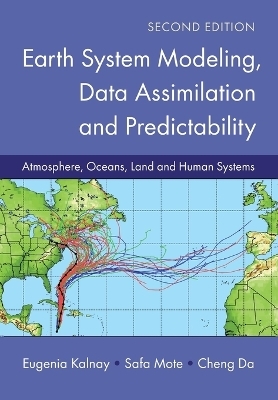
Earth System Modeling, Data Assimilation and Predictability
Cambridge University Press (Verlag)
978-1-107-40146-4 (ISBN)
Since the publication of the first edition of this highly regarded textbook, the value of data assimilation has become widely recognized across the Earth sciences and beyond. Data assimilation methods are now being applied to many areas of prediction and forecasting, including extreme weather events, wildfires, infectious disease epidemics, and economic modeling. This second edition provides a broad introduction to applications across the Earth systems and coupled Earth–human systems, with an expanded range of topics covering the latest developments of variational, ensemble, and hybrid data assimilation methods. New toy models and intermediate-complexity atmospheric general circulation models provide hands-on engagement with key concepts in numerical weather prediction, data assimilation, and predictability. The inclusion of computational projects, exercises, lecture notes, teaching slides, and sample exams makes this textbook an indispensable and practical resource for advanced undergraduate and graduate students, researchers, and practitioners who work in weather forecasting and climate prediction.
Eugenia Kalnay completed her Ph.D. at the Massachusetts Institute of Technology (MIT) under Jule Charney and became the first woman on the faculty in the Department of Meteorology. In 1979, she moved to NASA's Goddard Space Flight Center, where she developed the fourth-order global numerical model and led experiments in the new science called 'data assimilation.' In 1984, she became Head of NASA's Global Modeling and Simulation Branch. In 1987, she became Director of the National Oceanic and Atmospheric Administration's Environmental Modeling Center, where many improvements of models and data assimilation were developed for the National Weather Service forecasts. Her paper 'The NCEP/NCAR 40-year reanalysis project' (Kalnay et al., 1996) is the most cited paper in geosciences. In 1997, Kalnay became Lowry Chair at the University of Oklahoma and in 1999 became Atmospheric and Ocean Sciences Department Chair and professor at the University of Maryland, where she was later elected a Distinguished University Professor. Safa Mote is Assistant Professor of Computational and Applied Mathematics at Portland State University and Visiting Assistant Professor of Atmospheric and Oceanic Sciences at the University of Maryland who has worked on a wide range of challenging interdisciplinary problems. He has two Ph.D. degrees in Physics and in Applied Mathematics and Statistics, and Scientific Computing from the University of Maryland. He designs mathematical models to propose and assess holistic policies that lead to sustainability in interconnected environmental, economic, climate, and health systems. He develops computational methods based on Dynamical Systems, Machine Learning, and Data Assimilation to forecast extreme weather and climate events, improve subseasonal to seasonal predictions, and create projections for the coupled energy–water–food nexus. Cheng Da works on Coupled Data Assimilation as a postdoctoral research associate at the University of Maryland and the Global Modeling and Assimilation Office at NASA's Goddard Space Flight Center. Supported by the NASA Earth and Space Science Fellowship, he earned his Ph.D. degree under the supervision of Professor Kalnay at the University of Maryland, focusing on the assimilation of precipitation and nonlocal observations in the ensemble data assimilation system and coupled data assimilation. Before this, he earned his bachelor's and Master's degrees in Meteorology at Florida State University, working on radiance assimilation from spaceborne sensors.
Dedication; Preface to the Second Edition; Reviews and Comments on the First Edition; Foreword to the first edition; Acknowledgement in the First Edition; List of Variables; List of Abbreviations; 1. An overview of numerical weather prediction; 2. The continuous equations; 3. Numerical discretization of the equations of motion; 4. Introduction to the parameterization of subgrid-scale physical processes; 5. Data assimilation; 6. Atmospheric predictability and ensemble forecasting; A. Coding and checking the tangent linear and the adjoint models; B. Post-processing of numerical model output to obtain station weather fore-casts.
| Erscheinungsdatum | 25.10.2024 |
|---|---|
| Zusatzinfo | Worked examples or Exercises |
| Verlagsort | Cambridge |
| Sprache | englisch |
| Maße | 170 x 244 mm |
| Gewicht | 721 g |
| Themenwelt | Mathematik / Informatik ► Informatik ► Datenbanken |
| Naturwissenschaften ► Biologie ► Ökologie / Naturschutz | |
| Naturwissenschaften ► Geowissenschaften ► Meteorologie / Klimatologie | |
| ISBN-10 | 1-107-40146-1 / 1107401461 |
| ISBN-13 | 978-1-107-40146-4 / 9781107401464 |
| Zustand | Neuware |
| Informationen gemäß Produktsicherheitsverordnung (GPSR) | |
| Haben Sie eine Frage zum Produkt? |
aus dem Bereich


